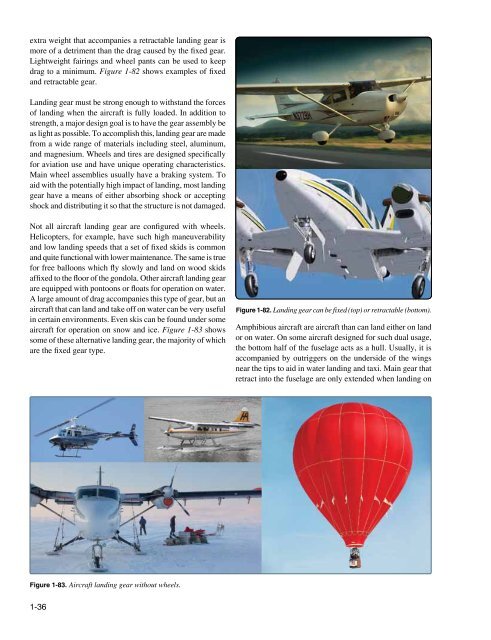Create successful ePaper yourself
Turn your PDF publications into a flip-book with our unique Google optimized e-Paper software.
extra weight that accompanies a retractable landing gear is<br />
more of a detriment than the drag caused by the fixed gear.<br />
Lightweight fairings and wheel pants can be used to keep<br />
drag to a minimum. Figure 1-82 shows examples of fixed<br />
and retractable gear.<br />
Landing gear must be strong enough to withstand the forces<br />
of landing when the aircraft is fully loaded. In addition to<br />
strength, a major design goal is to have the gear assembly be<br />
as light as possible. To accomplish this, landing gear are made<br />
from a wide range of materials including steel, aluminum,<br />
and magnesium. Wheels and tires are designed specifically<br />
for aviation use and have unique operating characteristics.<br />
Main wheel assemblies usually have a braking system. To<br />
aid with the potentially high impact of landing, most landing<br />
gear have a means of either absorbing shock or accepting<br />
shock and distributing it so that the structure is not damaged.<br />
Not all aircraft landing gear are configured with wheels.<br />
Helicopters, for example, have such high maneuverability<br />
and low landing speeds that a set of fixed skids is common<br />
and quite functional with lower maintenance. The same is true<br />
for free balloons which fly slowly and land on wood skids<br />
affixed to the floor of the gondola. Other aircraft landing gear<br />
are equipped with pontoons or floats for operation on water.<br />
A large amount of drag accompanies this type of gear, but an<br />
aircraft that can land and take off on water can be very useful<br />
in certain environments. Even skis can be found under some<br />
aircraft for operation on snow and ice. Figure 1-83 shows<br />
some of these alternative landing gear, the majority of which<br />
are the fixed gear type.<br />
Figure 1-82. Landing gear can be fixed (top) or retractable (bottom).<br />
Amphibious aircraft are aircraft than can land either on land<br />
or on water. On some aircraft designed for such dual usage,<br />
the bottom half of the fuselage acts as a hull. Usually, it is<br />
accompanied by outriggers on the underside of the wings<br />
near the tips to aid in water landing and taxi. Main gear that<br />
retract into the fuselage are only extended when landing on<br />
Figure 1-83. <strong>Aircraft</strong> landing gear without wheels.<br />
1-36



